Performance
It's important to point out that performance across the A660 range will vary greatly depending on configuration; there are nine unique A660 models to choose from.
Premium options are available with Core i5/Core i7 processors and discrete GPUs, but for the purpose of this review we're looking at the mid-range A660-17T.
Our £650 sample comes equipped with an entry-level Core i3 processor, 4GB of memory and integrated Intel HD graphics. To see how it compares, we're putting it up against four rival solutions measuring from 13.3in to 15.6in in size.
Here's a detailed look at the key specifications of the five notebooks in question, as well as a brief rundown of the benchmarks we use.
| Comparison systems | |||||
|---|---|---|---|---|---|
| Laptop | Toshiba Satellite A660-17T | Lenovo ThinkPad Edge 15 | Acer Aspire 5745DG | ASUS U35JC | Acer Timeline 3810T |
| Processor | Intel Core i3 350M (2.26GHz, 3MB L3 cache, dual-core) | Intel Core i5 430M (2.26GHz, 3MB L3 cache, dual-core) | Intel Core i5 450M (2.4GHz, 3MB L3 cache, dual-core) | Intel Core i3 370M (2.4GHz, 3MB L3 cache, dual-core) | Intel Core 2 Duo SU9400 (1.40GHz, 3MB L2 cache, dual-core) |
| Memory | 4GB DDR3 | 4GB DDR3 | 4GB DDR3 | 4GB DDR3 | 2GB DDR3 |
| Graphics | Intel HD Graphics | Intel HD Graphics | NVIDIA GeForce GT 425M 1GB | Intel HD Graphics + NVIDIA GeForce 310M 1GB | Intel GMA 4500MHD |
| Graphics driver | 8.15.10.2104 | Intel 8.15.10.2057 | NVIDIA Verde 259.12 | Intel 8.15.10.2182 + NVIDIA Verde 258.96 | Intel 7.15.10.1666 |
| Display | 16in - 1,366x768 | 15.6in - 1,366x768 | 15.6in - 1,366x768 | 13.3in - 1,366x768 | 13.3in - 1,366x768 |
| Battery | 6 cell, 48Whr | 6 cell, 48Whr | 12 cell, 99Whr | 8 cell, 84Whr | 6 cell, 56Whr |
| Weight | 2,547g (including battery) | 2,476g (including battery) | 2,839g (including battery) | 1,816g (including battery) | 1,645g (including battery) |
| Wireless | Intel Centrino Advanced-N 6200 AGN (802.11bgn) | Intel WiFi Link 1000 (802.11bgn) and Bluetooth 2.1 | Broadcom WLAN (802.11bgn) and Bluetooth 3.0 | Atheros AR9285 (802.11bgn) and Bluetooth 2.1 | Intel WiFi 5100 (802.11bgn) and Bluetooth 2.0 |
| Disk drive | Hitachi Travelstar 500GB HDD, 5,400RPM, 8MB cache | Seagate Momentus 320GB HDD, 5,400RPM, 8MB cache | Hitachi Travelstar 500GB HDD, 5,400RPM, 8MB cache | Seagate Momentus 320GB HDD, 5,400RPM, 8MB cache | Hitachi 500GB HDD, 5,400RPM, 8MB cache |
| Optical drive | DVD-RW | DVD-RW | Blu-ray/DVD RW combo | None | None |
| Operating System | Microsoft Windows 7 Home Premium, 64-bit | Microsoft Windows 7 Professional, 64-bit | Microsoft Windows 7 Home Premium, 64-bit | Microsoft Windows 7 Home Premium, 64-bit | Microsoft Windows 7 Home Premium, 32-bit |
| Benchmarks | |||||
| Geekbench | A cross-platform benchmark used to measure memory and processor performance. Run using high-performance mode. | ||||
| Cinebench | Using Cinebench's multi-CPU render, this cross-platform benchmark stresses as many cores as possible. Run using high-performance mode. | ||||
| 3DMark06 | A PC benchmark used to test the DirectX 9 performance of a system's graphics card. Run using high-performance mode. | ||||
| Battery test | In order to measure battery life, we run the notebook on balanced power settings and loop a 720p movie trailer, measuring the time taken to hibernate. | ||||
| Power consumption | Using balanced power settings, we record mains power draw whilst playing back a 720p movie trailer. | ||||
CPU and GPU performance
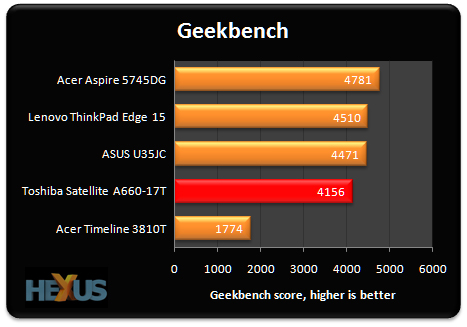
The A660's Core i3 350M CPU might be the slowest Core 2010 processor in our round up, but it's still a giant step up from the ultra-low-voltage Core 2 Duo found in the Acer Timeline.
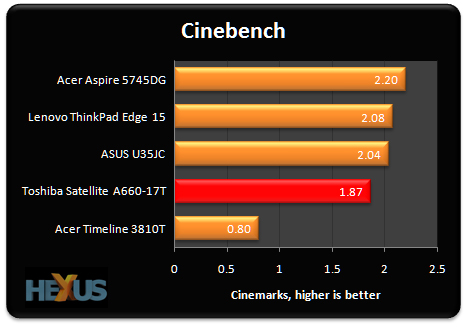
Cinebench tells a similar story, but how do these numbers translate to real-world usage?
Well, the A660 is perfectly suited to most everyday tasks. We found the notebook to be nippy whilst browsing the web and sending email, and Windows is able to boot in around 45 seconds.
The quad-thread chip is more than capable, and opening multiple windows or applications didn't introduce any noticeable slowdown.
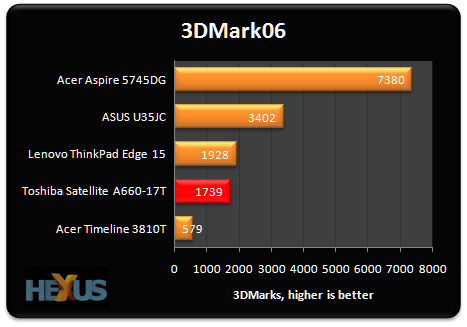
GPU performance meanwhile is limited, but the A660-17T's integrated Intel HD graphics processor had no trouble playing back full-HD 1080p video.
You won't be doing much 3D gaming, but the combination of an entry-level Core i3 processor and integrated Intel graphics should bode well for battery life.
Battery life and power consumption
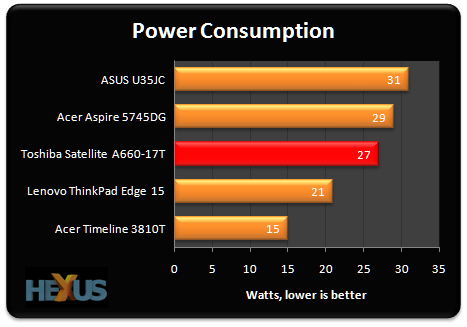
Or perhaps not. Surprisingly, we found the A660 consumed more power than we'd anticipated whilst playing back a 720p movie.
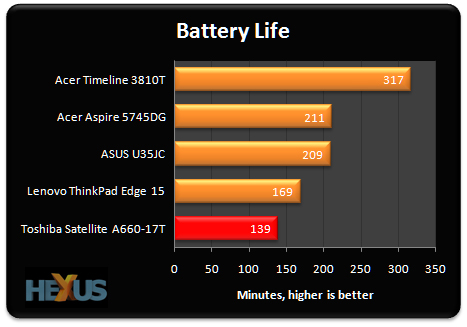
The sub-optimal power draw is reflected in the mediocre battery life. Failing to impress during our video run-down test, the A660-17T's six-cell battery managed to keep going for under two-and-a-half hours on a balanced power plan.
Hugely disappointing, and whilst switching to Toshiba's pre-configured eco mode helps, you're then sacrificing performance in order to squeeze out around three hours of light use. Considerably less than Toshiba's quoted maximum of four hours fifteen.









